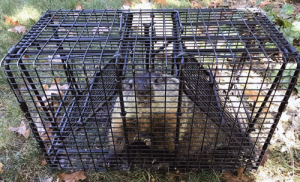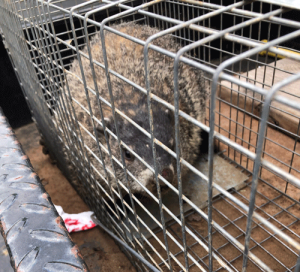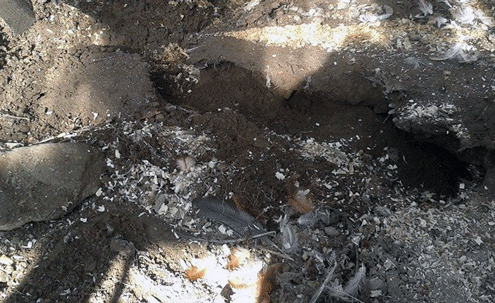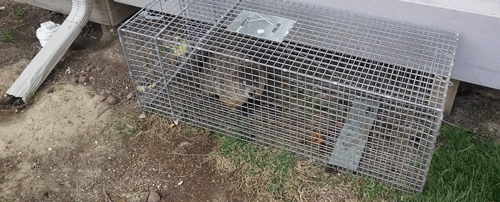How to get rid of groundhogs? (Humanely)
 HUMANE ELIMINATION OF GROUNDHOGS
HUMANE ELIMINATION OF GROUNDHOGS
Groundhogs (Marmota monax), also referred to as “woodchucks” are a species of animals closely related to squirrels and can be easily confused for them. They are seasonally active animals that fatten during summer and hibernate in winter.
General Characteristics
- Groundhogs are social animals that look out for each other and are sometimes referred to as whistling pigs due to their high whistling call to warn others of impending danger. They are herbivores and have been noticed to particularly enjoy dandelions, apples, melons, peas, carrots, clover, and corn.
- Though nimble tree climbers, woodchucks prefer to burrow underground and are more active on land. They eat food within their reach and live in their burrows.
- They possess sharp teeth that can cut through hard fibers and wood, nuts, and roots. Their feet are short but strong to aid in burrowing of earth and tree climbing.
- While squirrels easily transmit disease and ectoparasites such as ticks, fleas, and mites to farm animals, groundhogs stay clear of people and animals. They do not transmit common diseases except in cases when they become rabid.
- Groundhogs give birth to their young a month after mating and take care of them until they are old enough to fend for themselves. There are strict rules in some states against keeping groundhogs as pets, but they have been used in some published research works.
Negative Effects of Groundhogs
While it is true that groundhogs avoid humans and animals most times, they still cause some damage to plants, property, and buildings. Some of these include:
- Destruction of plants and crops:
Groundhogs enjoy feeding off many plants, some of which are ornamental flowers and grasses which are meant to beautify the environment. This defaces the yard and decreases aesthetics. They also enjoy feeding on crops and do a lot of damage to stalks, leaves, and roots, causing great losses to farmers. - Burrows:
Groundhogs live naturally in burrows and can dig burrows as long as 5 meters. While doing this, however, they may interfere with plant roots, house foundations, and underground piping systems, which may put the house and other structures in danger of collapse.  Endangering house pets:
Endangering house pets:
Groundhogs often avoid animals of other species and prefer to be left alone. The playful and curious nature of dogs and cats often puts them at risk because although groundhogs see these animals as predators and are naturally wary of them when they feel threatened, they attack and can inflict severe injury on your pets.- Utility damage:
With their strong teeth, groundhogs often gnaw at electric wires below the ground and damage the wiring system leaving you in danger of power outage. Their burrowing activities can also cause pipe breaks, which translate to water wastage and gas leaks. - Safety threat:
Unknowingly stepping into burrows can cause ankle twists and dislocations. This is a safety threat, especially with the presence of young children in the house. - Scaring farm animals:
It is common knowledge that animals like cattle and horses are easily spooked, so the sudden appearance of groundhogs from their burrows is likely to startle these animals and cause a stampede. This may cause injury and death to both farm animals and their human handlers. - Pose public health risks:
While it is true that groundhogs mostly avoid human contact, in the wild, they are likely to come in contact with other animals, especially within their clan. Some of these animals may be rabid and transmit the virus to groundhogs. Therefore, their presence in yards, playgrounds, and parks is a public health concern as this virus can easily be transmitted to humans through bites, scratches, or even be airborne when there is a high level of infection.
Though these animals are cute and seemingly harmless, the damage they are likely to cause, if not managed and controlled properly, may be very costly, hence the need to keep them in check.
Tips for Eliminating Groundhogs
Although groundhogs can be very destructive, it is necessary to ensure humane handling when dealing with them as they have rights and freedoms. We must ensure that they experience the least possible pain and injury when dealing with them, and any method of elimination we choose should guarantee their safety.
Here are seven interesting guidelines for eviction of groundhogs from your property:
- Build fences:
Especially if you live close to forest or bush areas, you can build a fence to separate your yard from the bush. Though these animals are tree climbers and can climb up the fence, they do not seem to think it is worth the stress. Most times, they prefer getting easily accessible food and burrowing instead of climbing. - Exploit their sensitivity:
Groundhogs have a keen sense of smell and get irritated by a lot of things. You can put any foul-smelling items around your property to keep them out. One of the most successful methods is the use of animal feces on the entrances of their burrows. - Use repellents:
These must be used with caution, and the manufacturer’s instructions must be strictly adhered to. Groundhogs also have an aversion to pepper and garlic, so these can be used in their burrows as natural repellents. - Play mind games:
Groundhogs are very intelligent animals and can sense the presence of humans or predators from a distance. This can be used to trick them into fleeing from your farm. The use of house pets like dogs and cats have been suggested, but this can be counterproductive as groundhogs have been known to attack and injure these animals when they feel threatened. The use of your pet’s urine can have the same effect as well as planting human hair around their burrows. - Eliminate their favorite foods and clean:
In keeping them out, you can remove their favorite foods from your garden or harvest them as soon as they are ripe. Make sure to also clean up the garden after harvesting so as not to attract groundhogs to the crop residues. - Set traps:
Box traps can be set lined with foods that groundhogs particularly like, to trap them and afterward release them to forests and bushes a good distance away from your property. - Adopt them:
In reality, all groundhogs need is a little tender loving care. So planting a few of their favorite foods some distance away from your property may look counter intuitive, but it will give the best of results.
It is very possible to get rid of groundhogs in your property and prevent them from being a nuisance to you, and at the same time, benefit the ecosystem by not killing them. This may take extra time and effort, but will definitely prove to be worth it.
How to Trap a Groundhog?

Also known as a woodchuck, groundhogs are naturally slow animals that commonly invade home gardens, eating and destroying vegetables and other woody structures. Despite being slow animals, capturing them can be a bit of a drag.
Groundhogs are highly sensitive animals. Just the slightest sense of danger will cause them to scurry quickly into their dark dens and only come out hours later when they are sure their environment is safe. This natural sense of survival makes it quite difficult for anyone to catch them.
Perhaps you have been wanting to trap a groundhog around your home and you don’t know the best way to do it? Right here we will be sharing simple guidelines on how to trap a groundhog. With this, you will be able to keep your home groundhog free.
Here are the guidelines on how to trap a groundhog;
Step 1:
The best way to catch a groundhog is to use either a wooden box trap or a wire cage trap. The dimension of either of these traps shouldn’t be more than 10” x 12” x 32” and the door should either be a single or double one. For effectiveness, the double door which serves as a pass-through trap is most recommended.
Step 2:
After getting your trap, you need to set it at the main entrance of the groundhogs’ burrow or just by the groundhogs’ major route. If you will be using this trap during hot weather, you need to cover the trap with a trap cover because groundhogs are highly susceptible to heat stress.
To attract the groundhog to your trap, you need to bait it with either cantaloupe, apple slices, or any other fresh fruits and vegetables. These baits must be replaced with fresh ones daily to help catch the attention of the groundhog.
When there is an abundant source of alternative food, there is a high tendency that the groundhog will ignore the bait. Once you notice that, try to wire the door of the trap and bait it as usual. At this point, the groundhog will attempt to take these baits without being caught. Repeat the same process and let him get away with it.
After the test game, remove the wire at the door, set the trap and bait it as usual with fresh fruits. The self-proclaimed smart groundhog will attempt to take away the bait the third time and will get trapped in the process.
While trying to trap a groundhog, you need to take into consideration the fact that these species of animals are only active during the day. This simply means that you only need to set the traps during the day time, precisely early in the morning, and remove or close it at night. This will help protect non-target animals that are nocturnal. Also, you need to check the trap twice daily to know if any groundhog has been trapped. Early notification will help facilitate the removal of the groundhog without any harm.
Step 3:
Trapping a groundhog comes with a lot of considerations. For instance, you need to make sure the groundhogs are not raising their young or hibernating when you are planning to trap them. To avoid this, try to remove the groundhog during early fall or late summer.
How to Keep Groundhogs from Digging Under My House, Deck, or Shed?
 Nothing can be more devastating than losing your home to the destructive activities of groundhogs that create burrows under the shed and deck of your beautiful house. If you are currently experiencing such at your home, there is no doubting the fact that you are looking for every possible way to get rid of these pests.
Nothing can be more devastating than losing your home to the destructive activities of groundhogs that create burrows under the shed and deck of your beautiful house. If you are currently experiencing such at your home, there is no doubting the fact that you are looking for every possible way to get rid of these pests.
Keeping groundhogs from digging might seem like a rather impossible thing to do because of their digging ability and being able to disappear with just the twinkle of an eye. But right here, we have the tips you need on how to keep groundhogs from digging under your house, deck, or shed.
Here are the prevention measures to put in place to keep groundhogs from digging under your house, deck, or shed:
1. Being able to create an extensive network of tunnels underneath the deck and shed of your home, one of the best ways to keep groundhogs from digging under your home is to use either hardware cloth or a galvanized wire that is sturdy to screen off all the openings in your home.
Depending on which of the two you decide to use, attach the wire to the edge of the opening at the lowest point and then bury the remaining part underground. By doing this, the wire should slant outward by approximately two feet.
2. Groundhogs are resilient and will always try to find their way back. However, they are sensitive to a very noisy environment and will often leave an environment when the noise becomes too discomforting.
Having discovered this, it is best to use it to your advantage to help keep them from digging under your house and deck. To use this method, all you have to do is frighten the groundhogs by creating a persistent loud noise. A loud radio or a motion-activated animal alarm can serve this purpose.
3. Creating a one-way door system and sealing up all other openings is another option that can help you to keep groundhogs from digging under your home. To ensure the doors are durable enough, you can buy pre-made doors in any commercial store nearby.
4. The use of odor repellent is another reliable way to keep groundhogs away. By placing them at strategic positions underneath the structures of your home, these repellents will create an irritating reaction that will make them go away.
5. If your house has a buried foundation, you will be needing something quite different to keep these animals out. In a house like this, you need to bury a galvanized wire mesh approximately 5 to 6 inches deep into the foundation and then extend the wire mesh horizontally about a foot away.
Factors to consider before evicting the groundhogs from digging under your house, deck or shed:
Before carrying out any of these preventive measures to evict the groundhogs digging under your house, there are certain things you need to consider. These include the breeding season of the animals and if there are young groundhogs present. (The best time to evict groundhogs is between late summer and early fall)
If any of these factors is present, you need to delay the removal process until the young groundhogs are active or the breeding season is over.
How to Make My Property Less Attractive to Groundhogs?
If you leave your property at the mercy of groundhogs, you are going to regret it by the time their infestation becomes unbearable and the damages caused by the animal outweighs what your property can handle. This is the major reason why you need to put preventative measures in place to help make your property less attractive to groundhogs.
Having taken into consideration the natural behavior and adaptation of groundhogs, we have prepared certain things that you can do to help keep these animals away from your property. With these simple tips, you will be able to make your property less attractive to groundhogs. 1. Remove the tall grasses around your property
1. Remove the tall grasses around your property
Apart from being a very good hiding spot, groundhogs feed on some grasses such as clover and dandelions. For you to make your property less attractive, you need to remove all the grasses in your home, or perhaps you can cut them short.
Keeping your lawn and other places on your property clean will make it impossible for groundhogs to hide will moving around during the day. This makes your property less attractive to groundhogs.
2. Fill the old tunnels around your property with crushed stone
When groundhogs visit your property, the first thing they look for is shelter. If they can’t find any, they will move to the next property. Having a keen understanding of this behavioral pattern, you need to make sure your property is free from any possible shelter points.
To get this done, you need to fill the old tunnels around your property with crushed stone and remove old and new tree stumps. With this, you will be making your property less attractive to groundhogs.
3. Use repellents
Several natural repellents can be used to make your property less attractive. For instance, you can sprinkle Epsom salts on the flowering part of your garden plants. Despite being a source of food for groundhogs, the salt will make it have a foul smell that will irritate the groundhogs.
Another common alternative is the use of garlic and pepper, castor oil, and ammonia. To use any of these, all you have to do is place it at strategic positions around your property. The only disadvantage with the use of these repellents is that it has to be occasionally reapplied whenever there are rainfalls.
4. Remove every possible groundhog nesting point
To make your property less attractive to groundhogs, you need to also eliminate every possible nesting point around your property. This includes woodpiles, dark shades under tunnels, and other cool spots.
For better protection, consider burying a welded wire with a three-foot square dimension at the entrance of tunnels around your property.
